Synthesis and Nanoarchitectonics of Novel Squaraine Derivatives for Organic Photovoltaic Devices
Abstract
1. Introduction
2. Materials and Methods
2.1. Preparing
2.1.1. Synthesis of Compounds 1a–1c
2.1.2. Synthesis of Compounds 2a, 2b, 3b, and 3c
2.1.3. Synthesis of Compounds 4a, 4b, 5b, and 5c
2.2. Deposition
2.3. Characterization
3. Results
3.1. Developing the Synthesis
3.1.1. Amine Preparation
3.1.2. Squaraine Preparation
3.1.3. UV-VIS Spectroscopic Characterization of the SQ Dyes
3.2. Developing the Films
3.2.1. Solvent Selection, Blending Ratio, and Deposition Conditions
3.2.2. Optical, Electrical, and Surface Characterization of SQ in Thin-Film Configuration
4. Conclusions
Author Contributions
Funding
Data Availability Statement
Acknowledgments
Conflicts of Interest
References
- Green, M.A.; Dunlop, E.D.; Hohl-Ebinger, J.; Yoshita, M.; Kopidakis, N.; Hao, X. Solar cell efficiency tables (version 56). Prog. Photovolt. Res. Appl. 2020, 28, 629. [Google Scholar] [CrossRef]
- Jeong, M.; Choi, I.W.; Go, E.M.; Cho, Y.; Kim, M.; Lee, B.; Jeong, S.; Jo, Y.; Choi, H.W.; Lee, J.; et al. Stable perovskite solar cells with efficiency exceeding 24.8% and 0.3 V voltage loss. Science 2020, 369, 1615–1620. [Google Scholar] [CrossRef] [PubMed]
- Fan, X.; Wang, J.; Wang, H.; Liu, X.; Wang, H. Bendable ITO-free Organic Solar Cells with Highly Conductive and Flexible PEDOT:PSS Electrodes on Plastic Substrates. ACS Appl. Mater. Interfaces 2015, 7, 16287–16295. [Google Scholar] [CrossRef]
- Qin, J.; Lan, L.; Chen, S.; Huang, F.; Shi, H.; Chen, W.; Xia, H.; Sun, K.; Yang, C. Recent Progress in Flexible and Stretchable Organic Solar Cells. Adv. Funct. Mater. 2020, 30, 2002529. [Google Scholar] [CrossRef]
- Fukuda, K.; Yu, K.; Someya, T. The Future of Flexible Organic Solar Cells. Adv. Energy Mater. 2020, 10, 2000765. [Google Scholar] [CrossRef]
- Roncali, J. Molecular Bulk Heterojunctions: An Emerging Approach to Organic Solar Cells. Acc. Chem. Res. 2009, 42, 1719–1730. [Google Scholar] [CrossRef] [PubMed]
- Do, T.T.; Stephen, M.; Chan, K.L.; Manzhos, S.; Burn, P.L.; Sonar, P. Pyrrolo[3,2-b]pyrrole-1,4-dione (IsoDPP) end capped with napthalimide or phthalimide: Novel small molecular acceptors for organic solar cells. Molecules 2020, 25, 4700. [Google Scholar] [CrossRef] [PubMed]
- Do, T.T.; Subbiah, J.; Manzhos, S.; Jones, D.J.; Bell, J.M.; Sonar, P. Phthalimide and naphthalimide: Effect of end-capping groups on molecular properties and photovoltaic performance of 9-fluorenone based acceptors for organic solar cells. Org. Electron. 2018, 62, 12–20. [Google Scholar] [CrossRef]
- Li, C.; Zhou, J.; Song, J.; Xu, J.; Zhang, H.; Zhang, X.; Guo, J.; Zhu, L.; Wei, D.; Han, G.; et al. Non-fullerene acceptors with branched side chains and improved molecular packing to exceed 18% efficiency in organic solar cells. Nat. Energy 2021, 6, 605–613. [Google Scholar] [CrossRef]
- Liu, F.; Zhou, L.; Liu, W.; Zhou, Z.; Yue, Q.; Zheng, W.; Sun, R.; Liu, W.; Xu, S.; Fan, H.; et al. Organic Solar Cells with 18% Efficiency Enabled by an Alloy Acceptor: A Two-in-One Strategy. Adv. Mater. 2021, 33, 2100830. [Google Scholar] [CrossRef]
- Jin, K.; Xiao, Z.; Ding, L. 18.69% PCE from organic solar cells. J. Semicond. 2021, 42, 060502. [Google Scholar] [CrossRef]
- Kim, W.; Choi, W. A novel parameter extraction method for the one-diode solar cell model. Sol. Energy 2010, 84, 1008–1019. [Google Scholar] [CrossRef]
- Bashahu, M.; Habyarimana, A. Review and test of methods for determination of the solar cell series resistance. Renew. Energy 1995, 6, 129–138. [Google Scholar]
- Su, Y.W.; Lin, Y.C.; Wei, K.H. Evolving molecular architectures of donor–acceptor conjugated polymers for photovoltaic applications: From one-dimensional to branched to two-dimensional structures. J. Mater. Chem. A 2017, 46, 24051–24075. [Google Scholar] [CrossRef]
- Law, K.Y. Organic photoconductive materials: Recent trends and developments. Chem. Rev. 1993, 93, 449–486. [Google Scholar] [CrossRef]
- Jipson, V.P.; Jones, C.R.J. Infrared dyes for optical storage. Vac. Sci. Technol. 1981, 18, 105–109. [Google Scholar] [CrossRef]
- Mori, T.; Miyachi, K.; Kichimi, T.; Mizutani, T. Electrical and Luminescent Properties of Color-Changeable Organic Electroluminescent Diode Using Squarylium Dyes. Jpn. J. Appl. Phys. 1994, 33, 6594–6598. [Google Scholar] [CrossRef]
- Chen, C.T.; Marder, S.R.; Cheng, L.T.J. Syntheses and Linear and Nonlinear Optical Properties of Unsymmetrical Squaraines with Extended Conjugation. Am. Chem. Soc. 1994, 116, 3117–3118. [Google Scholar] [CrossRef]
- Venkateswararao, A.; Wong, K.-T. Small Molecules for Vacuum-Processed Organic Photovoltaics: Past, Current Status and Prospect. Bull. Chem. Soc. Jpn. 2021, 94, 812–838. [Google Scholar] [CrossRef]
- Yao, H.; Wang, J.; Xu, Y.; Zhang, S.; Hou, J. Recent Progress in Chlorinated Photovoltaic Materials. Acc. Chem. Res. 2020, 53, 822–832. [Google Scholar] [CrossRef]
- Chen, G.; Sasabe, H.; Igarashi, T.; Hong, Z.; Kidoa, J.J. Squaraine dyes for organic photovoltaic cells. Mater. Chem. A 2015, 3, 14517–14534. [Google Scholar]
- Karak, S.; Homnick, P.J.; Della Pelle, A.M.; Bae, Y.; Duzhko, V.V.; Liu, F.; Russel, T.P.; Lahti, P.M.; Thayumanayan, S. Crystallinity and Morphology Effects on a Solvent-Processed Solar Cell Using a Triarylamine-Substituted Squaraine. Appl. Mater. Interfaces 2014, 6, 11376–11384. [Google Scholar] [CrossRef] [PubMed]
- Brück, S.; Krause, C.; Turrisi, R.; Beverina, L.; Wilken, S.; Saak, W.; Lützen, A.; Borchert, H.; Schiek, M.; Parisia, J. Structure–property relationship of anilino-squaraines in organic solar cells. Phys. Chem. Chem. Phys. 2014, 16, 1067–1077. [Google Scholar] [CrossRef]
- Rafique, S.; Abdullah, S.M.; Sulaiman, K.; Iwamoto, M. Fundamentals of bulk heterojunction organic solar cells: An overview of stability/degradation issues and strategies for improvement. Renew. Sustain. Energy Rev. 2018, 84, 43–53. [Google Scholar] [CrossRef]
- He, Y.; Li, Y. Fullerene derivative acceptors for high performance polymer solar cells. Phys. Chem. Chem. Phys. 2011, 12, 1970–1983. [Google Scholar] [CrossRef]
- Varma, P.C.R.; Namboothiry, M.A.G. Squaraine based Solution Processed Inverted Bulk Heterojunction Solar Cells Processed in Air. Phys. Chem. Chem. Phys. 2016, 18, 3438–3443. [Google Scholar] [CrossRef][Green Version]
- He, J.; Jo, Y.J.; Sun, X.; Qiao, W.; Ok, J.; Kim, T.; Li, Z. Squaraine Dyes for Photovoltaic and Biomedical Applications. Adv. Funct. Mater. 2021, 31, 2008201. [Google Scholar] [CrossRef]
- Wang, S.; Hall, L.; Diev, V.V.; Haiges, R.; Wei, G.; Xiao, X.; Djurovich, P.I.; Forrest, S.R.; Thompson, M.E. N,N-Diarylanilinosquaraines and Their Application to Organic Photovoltaics. Chem. Mater. 2011, 23, 4789–4798. [Google Scholar] [CrossRef]
- Della Pelle, A.M.; Homnick, P.J.; Bae, Y.; Lahti, P.M.; Thayumanavan, S. Effect of Substituents on Optical Properties and Charge-Carrier Polarity of Squaraine Dyes. J. Phys. Chem. C 2014, 118, 1793–1799. [Google Scholar] [CrossRef]
- Sasabe, H.; Igrashi, T.; Sasaki, Y.; Chen, G.; Hong, Z.; Kido, J. Soluble squaraine derivatives for 4.9% efficient organic photovoltaic cells. RSC Adv. 2014, 4, 42804–42807. [Google Scholar] [CrossRef]
- Bak, H.Ø.; Nielsen, B.E.; Jeppesen, A.; Brock-Nannestad, T.; Nielsen, C.B.O.; Pittelkow, M. Laser Welding of Polymers using Unsymmetrical Squaraine Dyes. J. Polym. Sci. A Polym. Chem. 2018, 56, 2245–2254. [Google Scholar] [CrossRef]
- Beverina, L.; Drees, M.; Facchetti, A.; Salamone, M.; Ruffo, R.; Pagani, G.A. Bulk Heterojunction Solar Cells—Tuning of the HOMO and LUMO Energy Levels of Pyrrolic Squaraine Dyes. Eur. J. Org. Chem. 2011, 28, 5555–5563. [Google Scholar] [CrossRef]
- Somashekharappa, G.M.; Govind, C.; Pulikodan, V.K.; Paul, M.; Namboothiry, M.A.G.; Das, S.; Karunakaran, V. Unsymmetrical Squaraine Dye-Based Organic Photodetector Ehxibiting Enhanced Near Infrared Sensitivity. J. Phys. Chem. C 2020, 124, 21730–21739. [Google Scholar] [CrossRef]

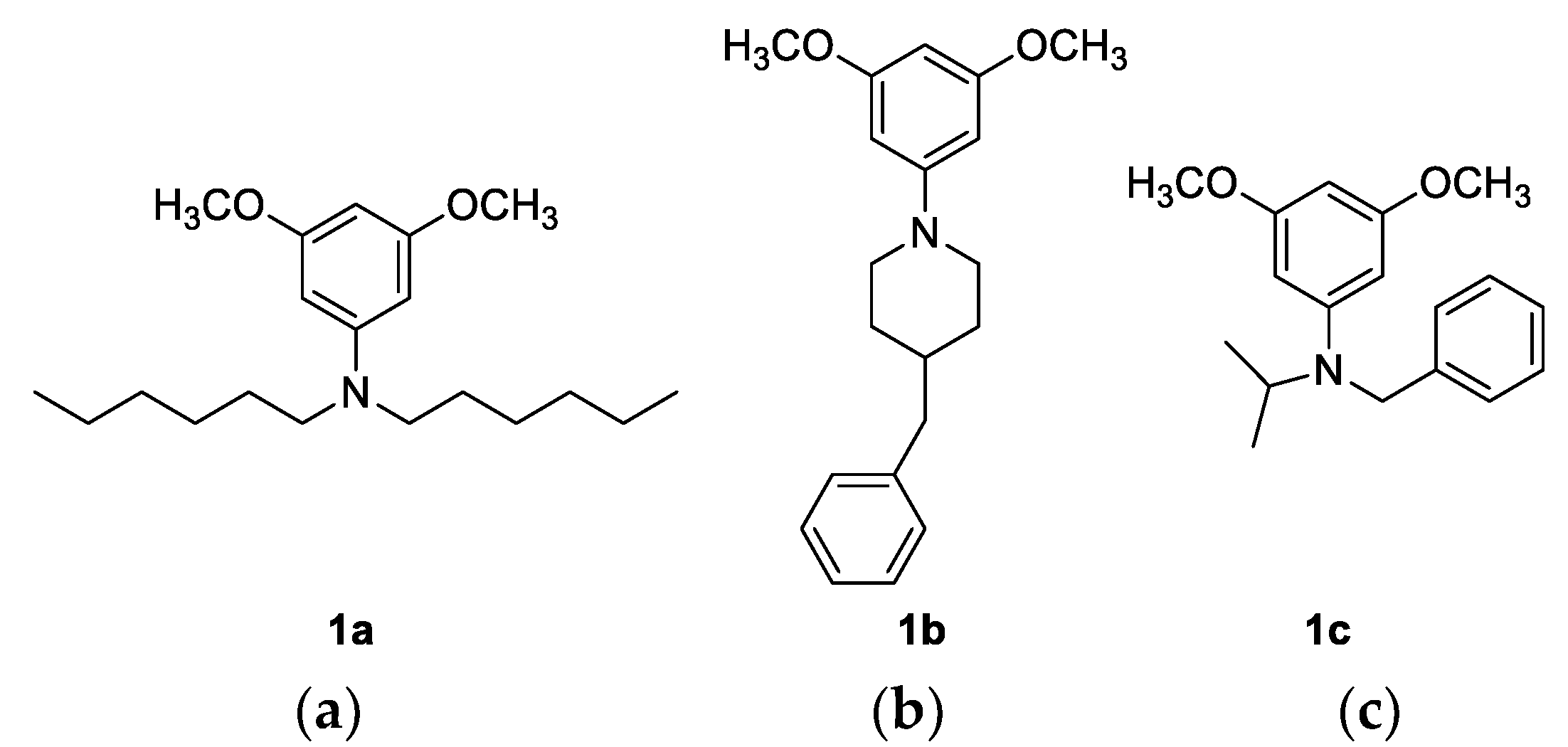
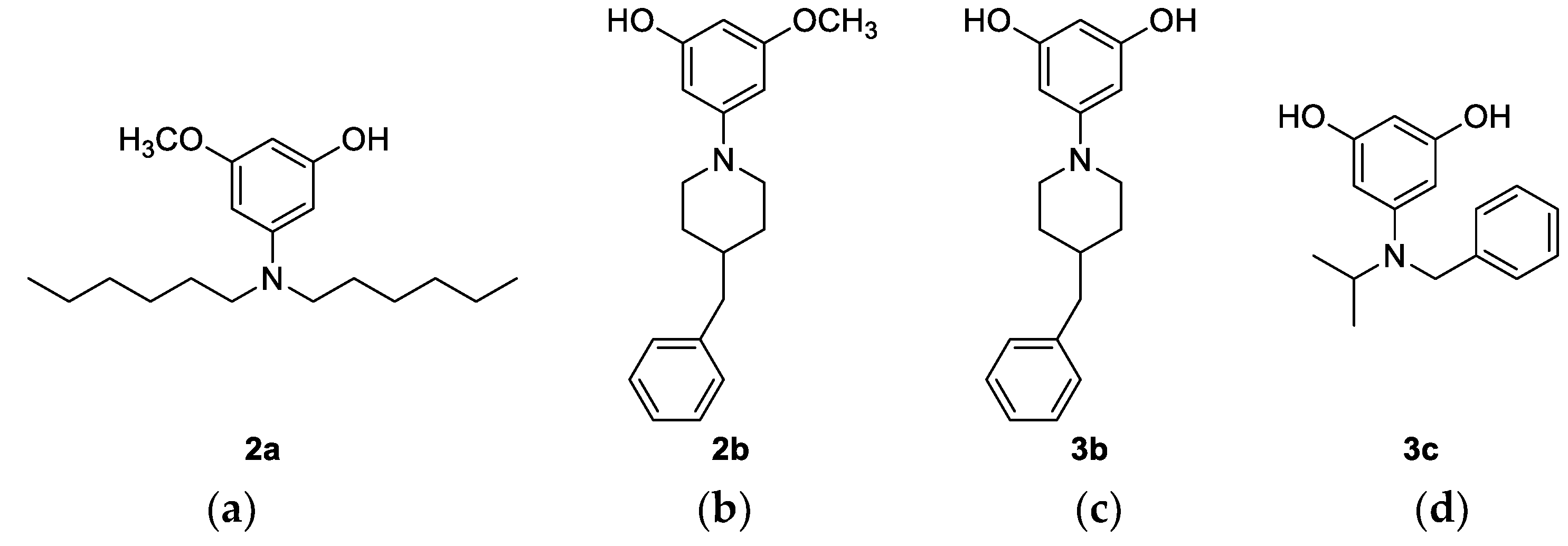
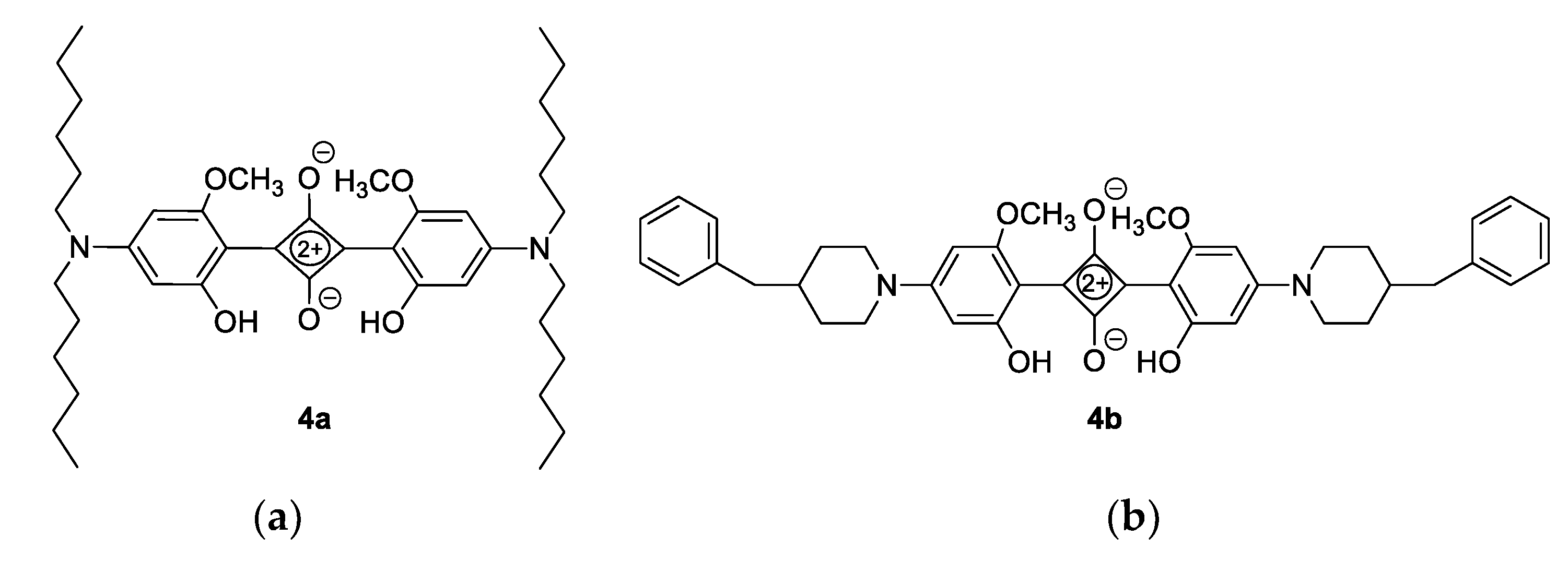

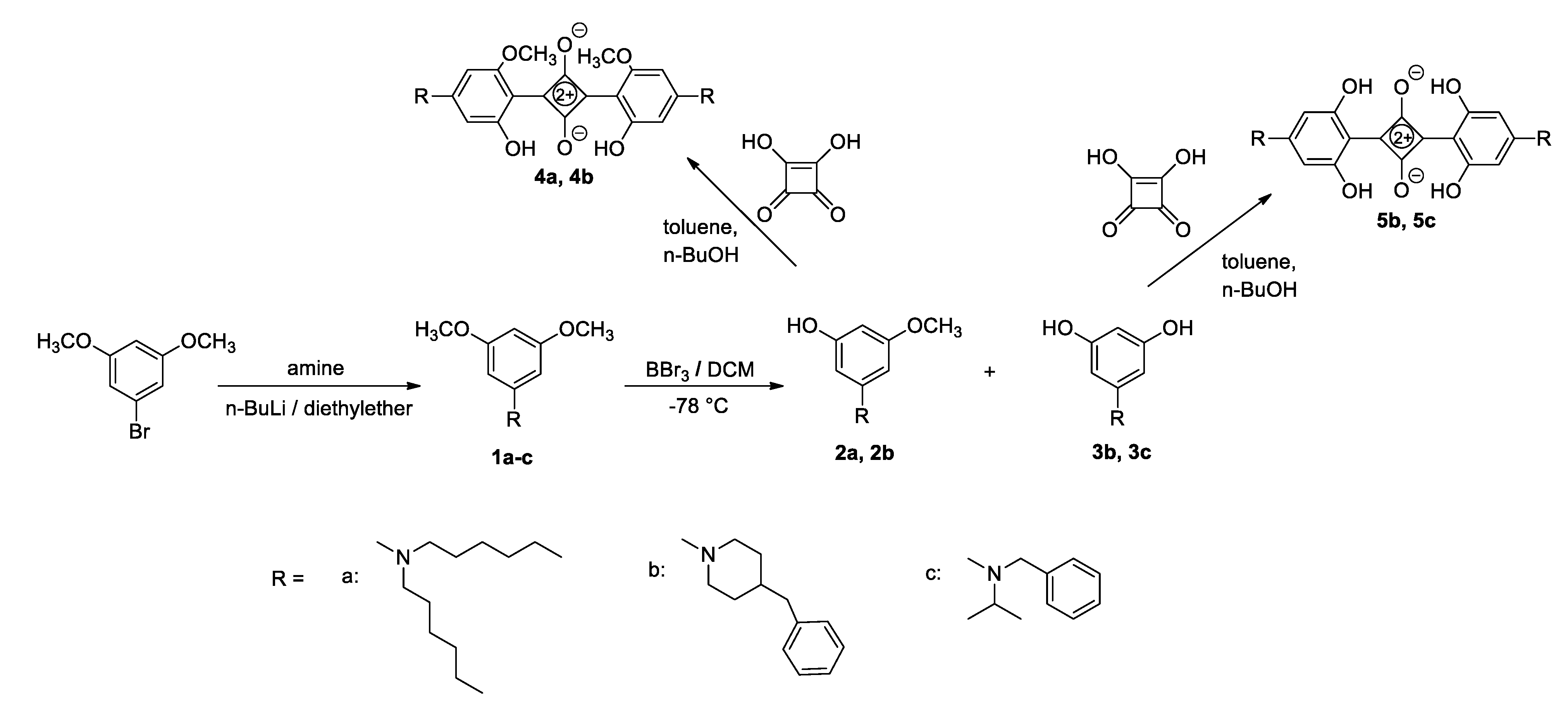
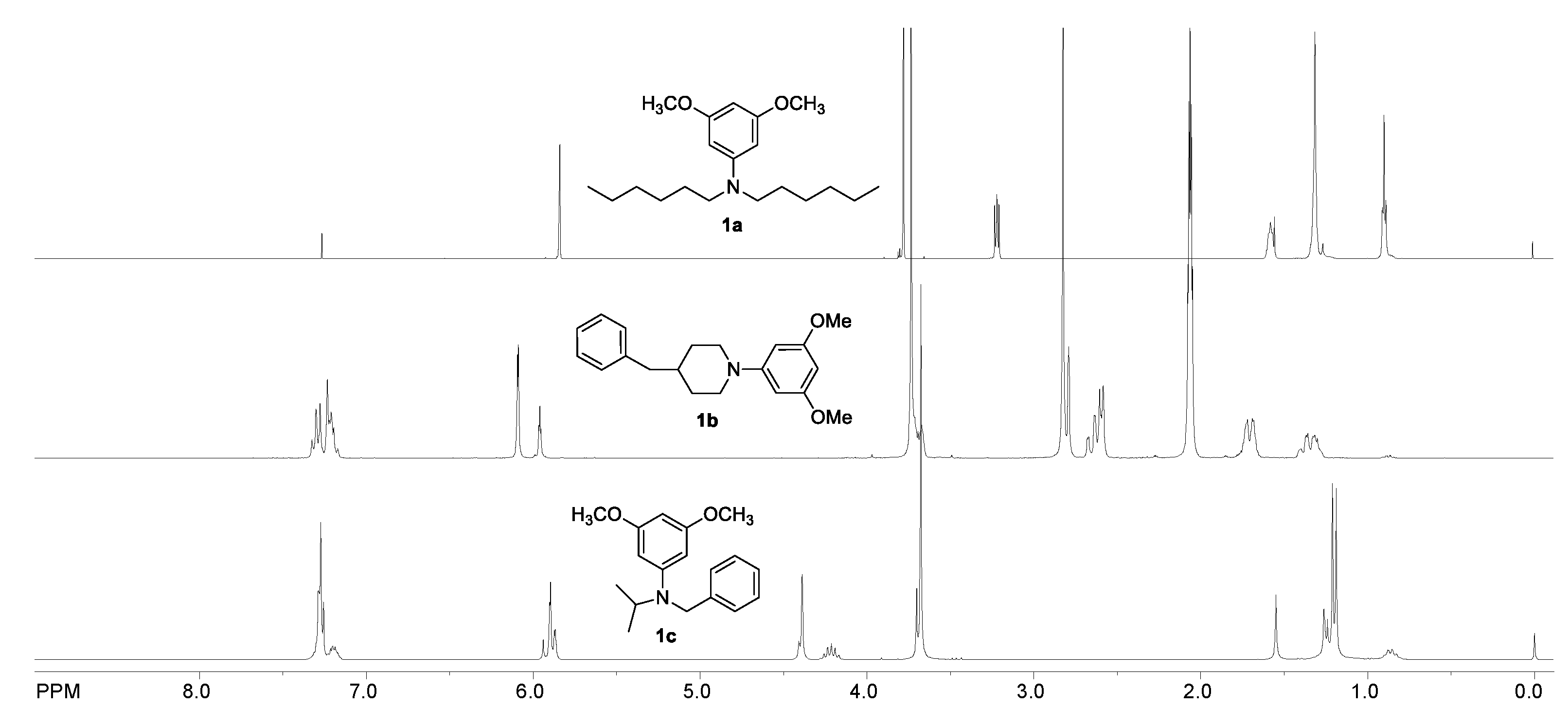
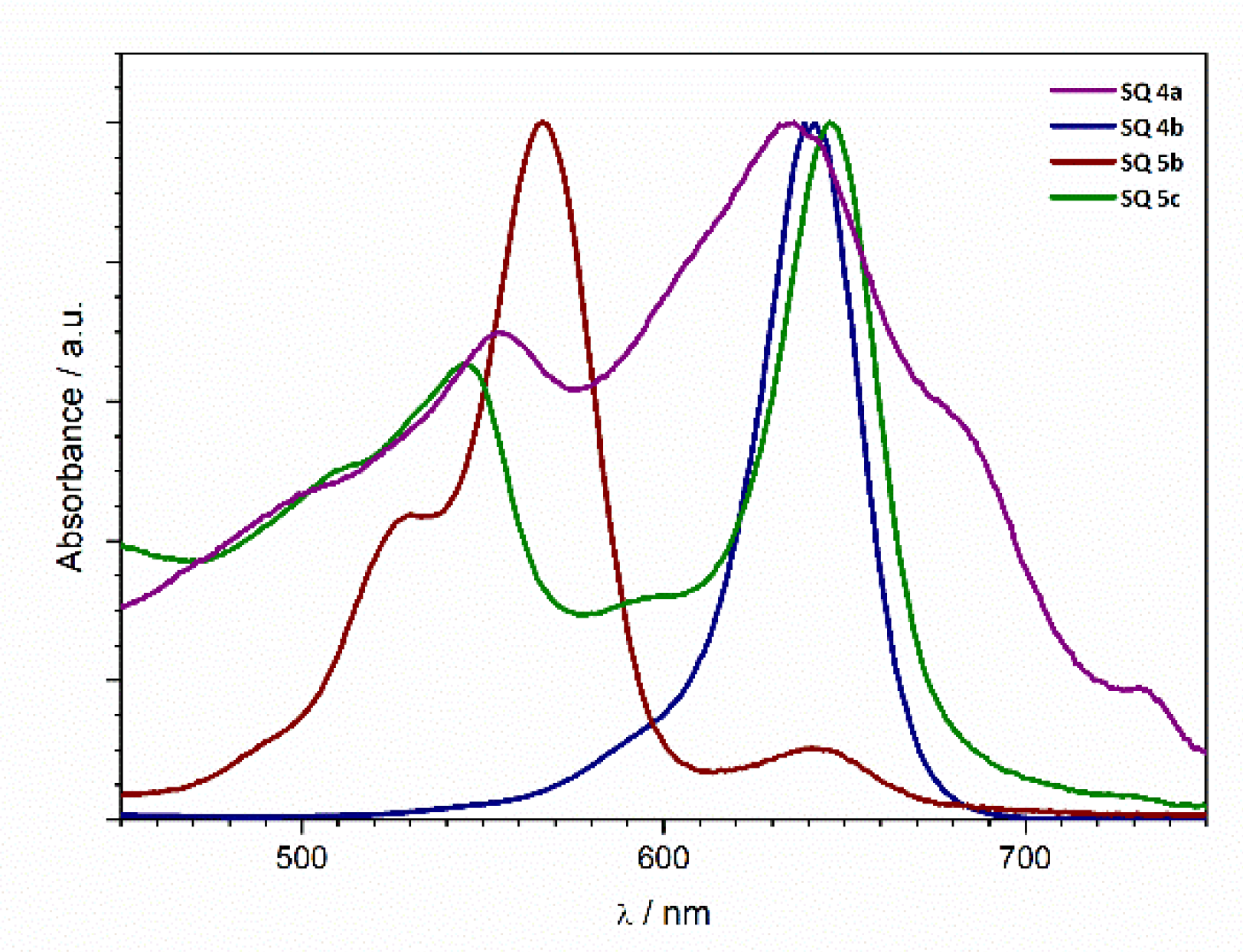
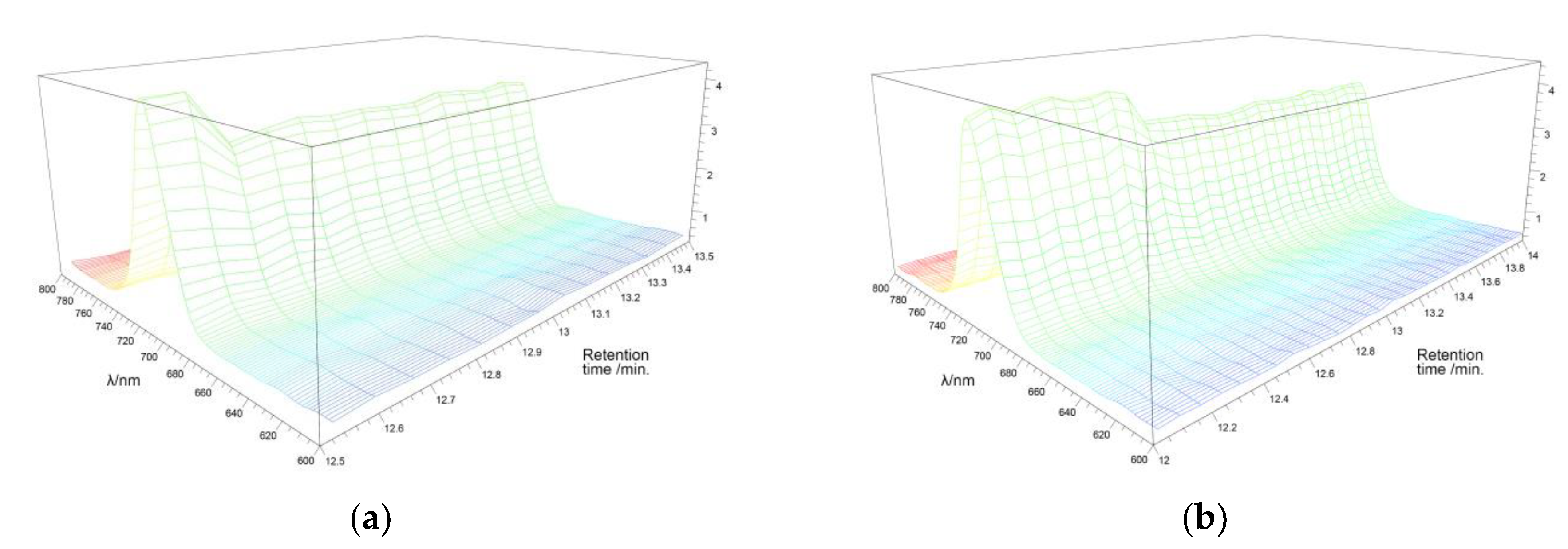
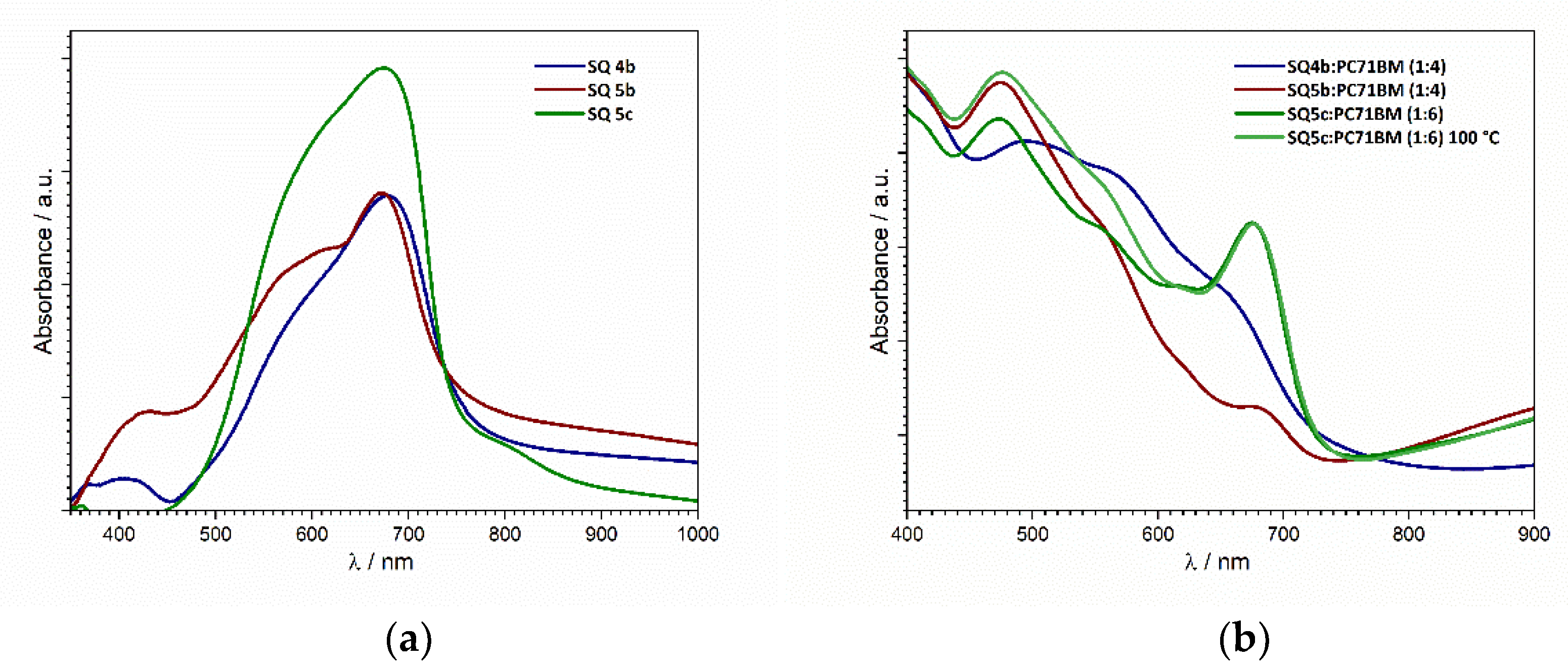
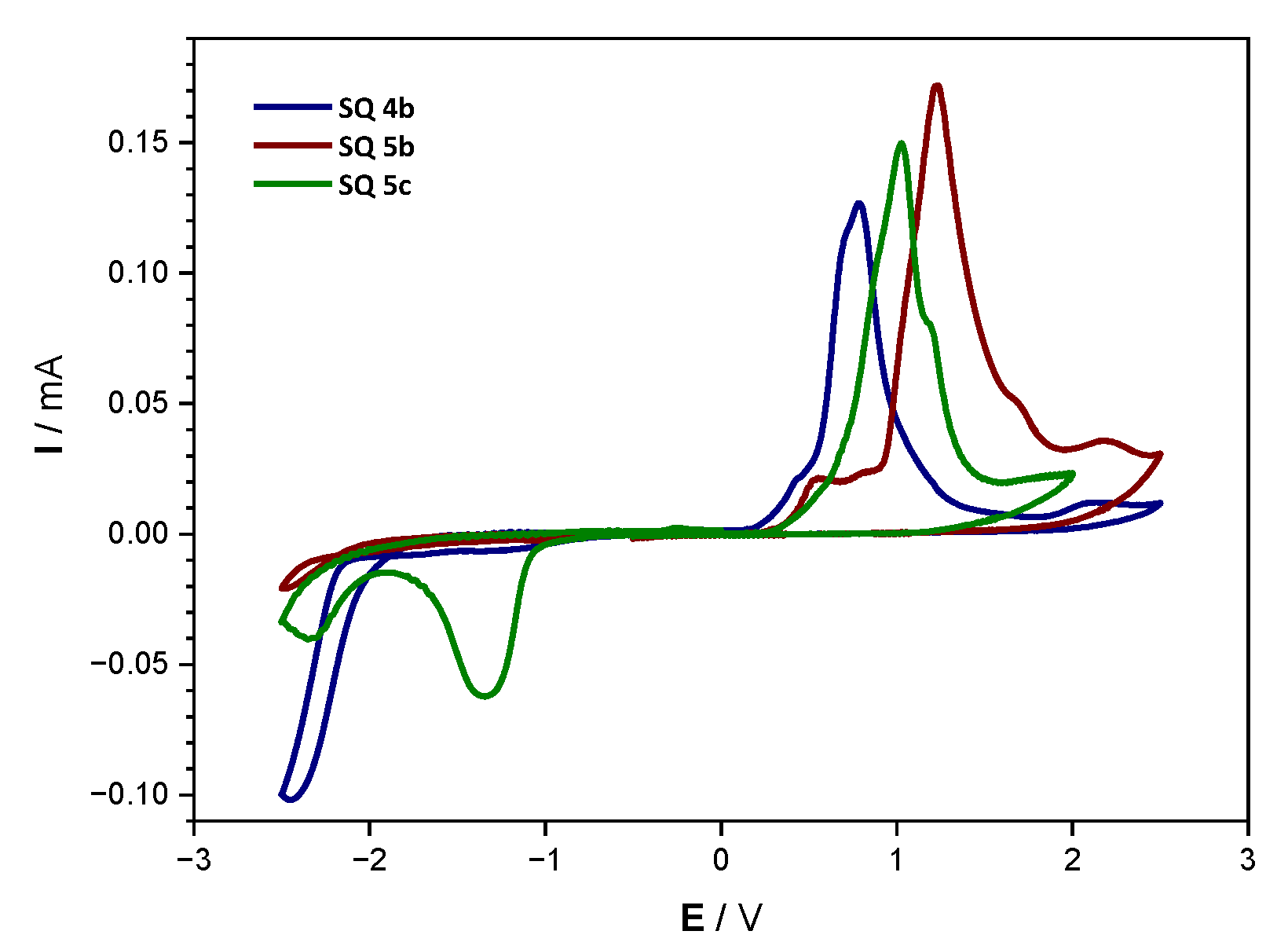

| Sample | Solvent | Total Concentration (mg mL−1) | Speed (rpm)/ramp (rpms−1) | Film Thickness (nm) | Average RMS/nm |
|---|---|---|---|---|---|
| 1 (5c) | CF | 20 | 1000/1000 | 110 | 1–5 |
| 2 (5b) | CF | 20 | 1000/2000 | 90 | |
| 3 (5c) | CF | 20 | 1000/3000 | 80 | |
| 4 (5c) | CF | 20 | 3000/3500 | 50 | |
| 5 (4b) | CF | 20 | 3000/2000 | 80 | |
| 6 (4b) | CF | 20 | 2000/1000 | 90 | |
| 7 (5b) | CF | 20 | 2000/2000 | 70 | |
| 8 (5c) | CF | 40 | 2000/2000 | 250 | 50–100 |
| 9 (5c) | CF | 40 | 3000/2000 | 150 | |
| 10 (5c) | CF | 40 | 1000/3000 | 200 | |
| 11 (5b) | o-DCB | 20 | 3000/3000 | 20 | 5–10 |
| 12 (5b) | o-DCB | 20 | 1000/3000 | 30 | |
| 13 (5b) | o-DCB | 20 | 3000/1000 | 30 |
| Time (min) | A (%) | B (%) |
|---|---|---|
| 0.00 | 100.0 | 0.0 |
| 2.00 | 100.0 | 0.0 |
| 10.00 | 5.0 | 95.0 |
| 21.00 | 5.0 | 95.0 |
| 22.00 | 100.0 | 0.0 |
| 28.00 | 100.0 | 0.0 |
| Compound | Cyclic Voltammetry | UV-VIS Spectroscopy | |||
|---|---|---|---|---|---|
| HOMO (eV) | LUMO (eV) | Eg (eV) | Eg (eV) | LUMO (eV) * | |
| 4b | −5.07 | - | - | 1.65 | −3.42 |
| 5b | −5.19 | - | - | 1.67 | −3.52 |
| 5c | −5.34 | −3.68 | 1.66 | 1.66 | −3.68 |
Publisher’s Note: MDPI stays neutral with regard to jurisdictional claims in published maps and institutional affiliations. |
© 2022 by the authors. Licensee MDPI, Basel, Switzerland. This article is an open access article distributed under the terms and conditions of the Creative Commons Attribution (CC BY) license (https://creativecommons.org/licenses/by/4.0/).
Share and Cite
Vuk, D.; Radovanović-Perić, F.; Mandić, V.; Lovrinčević, V.; Rath, T.; Panžić, I.; Le-Cunff, J. Synthesis and Nanoarchitectonics of Novel Squaraine Derivatives for Organic Photovoltaic Devices. Nanomaterials 2022, 12, 1206. https://doi.org/10.3390/nano12071206
Vuk D, Radovanović-Perić F, Mandić V, Lovrinčević V, Rath T, Panžić I, Le-Cunff J. Synthesis and Nanoarchitectonics of Novel Squaraine Derivatives for Organic Photovoltaic Devices. Nanomaterials. 2022; 12(7):1206. https://doi.org/10.3390/nano12071206
Chicago/Turabian StyleVuk, Dragana, Floren Radovanović-Perić, Vilko Mandić, Vilma Lovrinčević, Thomas Rath, Ivana Panžić, and Jerome Le-Cunff. 2022. "Synthesis and Nanoarchitectonics of Novel Squaraine Derivatives for Organic Photovoltaic Devices" Nanomaterials 12, no. 7: 1206. https://doi.org/10.3390/nano12071206
APA StyleVuk, D., Radovanović-Perić, F., Mandić, V., Lovrinčević, V., Rath, T., Panžić, I., & Le-Cunff, J. (2022). Synthesis and Nanoarchitectonics of Novel Squaraine Derivatives for Organic Photovoltaic Devices. Nanomaterials, 12(7), 1206. https://doi.org/10.3390/nano12071206






